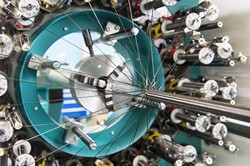Nuclear materials developed for a sustainable future
The MATISSE(opens in new window) project provided the foundation for an integrated European research programme, which investigated innovative materials that can be used to ensure a safe and sustainable nuclear sector. The initiative comprised a combination of collaborative projects as well as coordination and support actions by research institutes. By bringing together 27 organisations from 10 European countries (including an international partner from South Korea), MATISSE allowed researchers to participate in the latest European initiatives, developing advanced materials for nuclear energy production. The aim was to foster links between respective national research programmes by networking and integrating activities on material innovation for advanced nuclear systems, sharing partners’ best practices and developing efficient communication tools. “Under the auspices of the European Energy Research Alliance (EERA), project partners established a Joint Programme on Nuclear Materials (JPNM) to improve coordination of national initiatives, European fundraising programmes and other collaborations,” explains project coordinator Dr Pierre-François Giroux. The consortium targeted R&D activities considered priorities by JPNM partners, leading to progress in the fields of conventional materials, advanced materials and predictive capabilities. New materials with improved properties The project furthered three ‘Grand Challenges’ defined by the EERA-JPNM, including the elaboration of design rules, assessment and test procedures suitable for the expected operating conditions and the materials envisaged. The other challenges involved the development of physical models coupled to advanced microstructural characterisation to achieve high-level understanding of predictive capability, and the development of new materials with superior thermo-mechanical properties and radiation-resistance. “These three Grand Challenges must be addressed and resolved to take full advantage of the nuclear Generation IV technology, with respect to safety, performance and cost,” Dr Giroux points out. Supporting the evolution of the JPNM into an integrated research programme involving Member States, the European Commission and the main European stakeholders was one of the project’s main targets. The MATISSE framework was used to implement the JPNM and a medium- to long-term strategy devised, together with a road-map and access scheme for large-scale research infrastructures. ODS alloys and ceramic composites investigated The consortium prepared governance, financial and management structures, while implementing schemes for education and training, networking, dissemination and communication. In addition, project partners identified priority areas for conducting research, leading to significant results in areas such as assessing the effects of irradiation-induced hardening and creep mechanism on the performance of ferritic/martensitic alloys. Scientists also selected functional coatings, modified surface layers, and classified phenomena such as fuel-cladding interaction and environment assisted degradation of steels in liquid lead alloys. Researchers also investigated the potential of oxide dispersion strengthened (ODS) alloys and ceramic composites for advanced fuel cladding and novel structural materials for fast neutron reactors. “They studied and enhanced the pre-designs and properties of ODS steels and ceramic composites for cladding applications in order to enlarge the database of commercially available materials to be used for fast neutron reactor prototypes,” says Dr Giroux. MATISSE established key priorities in advanced nuclear materials research, identified funding opportunities and harmonised this scientific and technical domain at the European level by maximising complementary research and synergies with the major actors in this field. Dr Giroux concludes: “The mix of R&D on both conventional and advanced materials is positive for nuclear systems in general. In the short- to medium-term, prototypes will be built with off-the-shelf materials and the first core fuelled with conventional fuel elements, while in the long-term advanced materials will be tested and qualified in order to be implanted in these new nuclear systems.”







